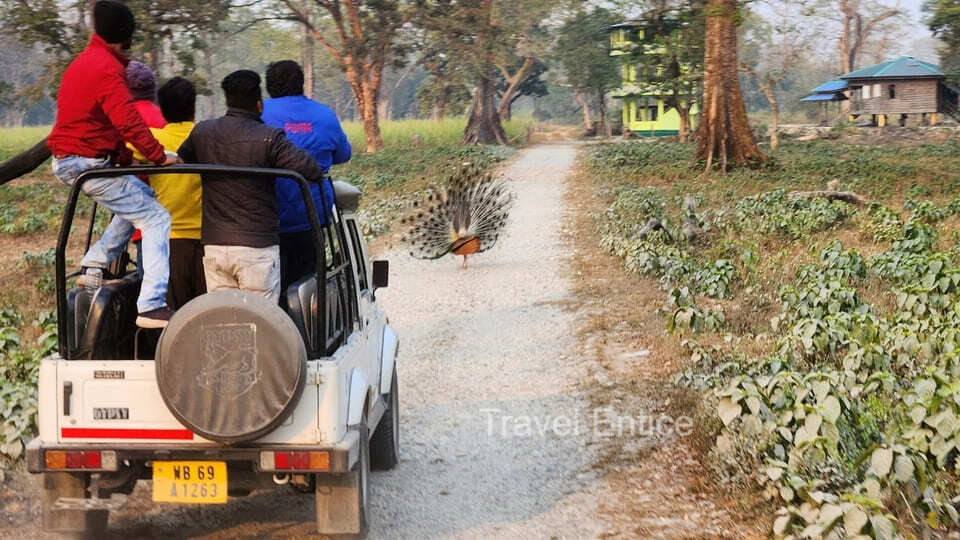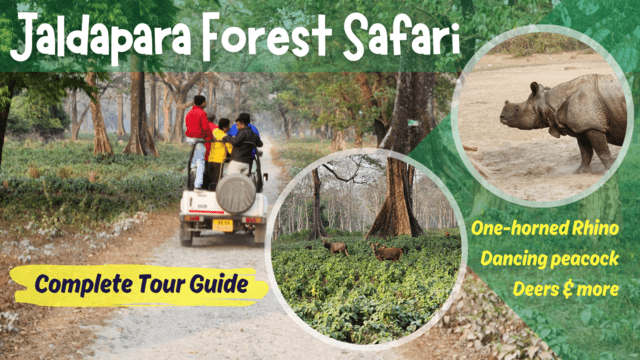Perched in the foothills of the Eastern Himalayas, nestled along the western bank of the Torsa River, Jaldapara National Park emerges as a prime destination for tourists exploring the Dooars region of northern West Bengal. Boasting a diverse array of flora and fauna, this wildlife sanctuary is famed for providing a safe haven for the Indian one-horned rhinoceros. In addition to this iconic species, the park is home to a variety of wildlife including deer, peacocks, porcupines, monkeys, mongooses, martens, Indian bison, and more.
The allure of jungle safaris through the lush grassland of Jaldapara captivates travelers from across the globe, making it a must-visit destination for nature enthusiasts exploring the Dooars region. Whether you’re planning a vacation or seeking to immerse yourself in the wilderness, Jaldapara National Park promises an unforgettable experience.
Let’s delve deeper into how you can plan an enriching trip to Jaldapara and its surroundings.
A brief History of Jaldapara National park

Situated approximately 82km away from NJP, in the Alipurduar district of West Bengal, Jaldapara National Park boasts a rich history.
In the 1800s, the region was inhabited by the Toto and Mech (Bodo) tribes, who coexisted with the area’s wildlife. The area was later recognized as suitable for preserving endangered species. In 1941, it was designated as a sanctuary to protect its diverse flora and fauna, including the critically endangered Indian Rhinoceros; as a result the vast grasslands and riverine forests were declared a sanctuary in 1943. This sanctuary was upgraded to the status of a National Park in May 2012.
Spanning 216.51 sq km, the park stretches approximately 50 km in length, with a narrower width ranging between 5-7 km.
Activities at Jaldapara National Park
Embarking on Jungle safari at Jadapara Wildlife Sanctuary is one of the most demanding activities for the Dooars tourists. Here, you can immerse yourself in two types of safaris firsthand:
- Jeep safari
- Elephant safari
- bird watching safari
The last one (bird watching) is quite popular among wildlife photographers. If you are a bird-watching and photography enthusiast, you must pay the entry fees, obtain permission from the forest authority, and enlist the services of a knowledgeable bird-watching guide. This allows for a captivating day spent capturing images of the diverse bird species inhabiting Jaldapara National Park. In the section below, you’ll discover a concise list of some of the special bird species found within the park.
Now, let’s delve into further details about safari options that are popular among regular tourists.
Jeep Safari

The Jeep safari offers a quicker exploration covering a broader area, although it may not venture deep into the grasslands or bring you up close to the rhinos. Nonetheless, it provides a satisfying experience of encountering roadside wildlife and observing rhinos in the grassland and salt lick area.
Rent: INR 4500/Jeep
| Shifts | Timings (Nov-March) | Timings (April-October) |
|---|---|---|
| 1st Shift | 6 AM to 7:30 AM | 5:30 AM to 7 AM |
| 2nd Shift | 7:30 AM to 9 AM | 7 AM to 8:30 AM |
| 3rd Shift | 3 PM to 4:30 PM | 3:30 PM to 5 PM |
Elephant Safari
Embarking on an adventurous elephant ride in the morning session promises an exhilarating journey deep into the grasslands, offering thrilling encounters. Witnessing rhinos in muddy ponds, herds of elephants, and the graceful sprint of deer are among the captivating experiences awaiting you in Jaldapara.
For the ultimate excitement, don’t miss out on the spontaneous elephant ride, which can be booked on the spot for an unforgettable adventure.
| Shift | Timings | Rent |
|---|---|---|
| 1st shift | 5:30 AM To 6:30 AM | INR 1450 / – per Seat |
| 2nd shift | 6:30 AM To 7:30 AM | INR 1450 / – per Seat |
| 3rd shift | 7:30 AM To 8:30 AM | INR 1450 / – per Seat |
Note: Jaldapara National Park remains closed on every Thursday. Also, the park remains closed from June 15th to September 15th, coinciding with the breeding season of many wildlife species.
Safari Experience at Jaldapara NP
Jaldapara National Park unfolds as vast grasslands rather than traditional forests, boasting approximately 240 species of grass across its expanse. During your safari at Jaldapara, your vision spans across expansive landscapes teeming with wildlife. You may expect sightings of peacocks, various bird species, and a diverse array of deer such as Sambar, hog deer, barking deer, and spotted deer. Keep a keen eye out for the Indian one-horned rhinoceros, often spotted in specific areas like salt licks, muddy lands, and hidden within the grasslands.
The elephant safari ventures into thrilling territories within the grasslands, traversing water bodies and muddy terrain, offering heightened chances of witnessing rhinos and other elusive creatures.
On the other hand, the jeep safari covers a larger area within a shorter duration, providing opportunities to spot deer and peacocks freely roaming, even along the roads. Also you may have glimpses of rhinos can be caught at salt licks and amidst tall roadside tall grasses.
The jeep safari generally take you up to Totopara and Hollong tourist Lodge in Jaldapara National Park. The later one is a great place to enjoy overnight experience and capture few extra pieces of wild activities in your camera.
Below, check the lists of wilds that are habitats of Jaldapara National Park.
Wildlives in Jaldapara National Park
Animals
Indian One-horned Rhinoceros, sambhar, barking deer, spotted deer, hog deer, Monkeys, wild pigs, Gour (Indian bison), and elephants.
Reptiles
Python, monitor lizards, krates, cobras, geckos, and 8 species of freshwater turtles are found in Jaldapara National Park.
Birds at Jaldapara
Peacock density is pretty high in Jaldapara National Park. If you are fortunate visitors can see the dancing Peacock displaying his full array of feathers, especially during the breeding season. Also, it is one of the very few places in India, where the Bengal Florican is sighted.
Other birds found here are
the Crested Eagle, Pallas’s Fishing Eagle, shikra, Pied Harrier, Common Buzzard, Kestrel, Sparrow Hawk Jungle fowl, Indian peafowl, patridges, Oriental Pied Hornbill, Great Hornbill, lesser Pied Hornbill, Lesser Adjutant Stork, Green Pigeons, Barbets, Parakeets, Woodpeckers, Cuckoos, Orioles, Drongos, Babblers, Thrushes, Indian Shag, Darter, Egrets, Lesser, Pied Wagtail, Spur Winged Lapwing, Moorhen, White Breasted Waterhen, Shaheen Falcon, Large Green billed Malkoha and White Rumped Vulture.
Among Common birds are doves, Bee-eaters, Rollers, Hoopoe, Shrikes, Larks, Hill Mynas, Bulbuls, Finches.
The night hunters: Owls and nightjars.
Other places to visit near Jaldapara
Toto Para
Adjacent to Jaldapara National Park, Toto Para is a village that entices those interested in ethnic tourism. It’s the sole settlement of the Toto Tribe, one of the world’s most endangered ethnic communities. Exploring their traditional culture offers a valuable experience during your trip to Jaldapara.
Chilapata Forest
Unlike the vast grassland in Jaldapara National Park, Chilapata Forest is deep and dense, known as the most densely wooded area in the region. Embarking on a jungle safari here can be an exceptional experience. Deep within Chilapata Forest, you’ll discover the ruins of a thousand-year-old fort belonging to the Nal King, constructed during the Gupta Empire in the 5th century, holding immense historical and archaeological significance. Notably, the forest is home to a unique tree known as the Ramsupari tree, which exudes red fluid upon cutting, resembling mammalian blood. Witnessing such a botanically significant species can be a remarkable achievement in Chilapata Forest.
Khairbari
Situated on the western side of Jaldapara National Park, Khairbari is a small forest renowned for its leopard rescue center, named the “South Khairbari Leopard Rescue Center,” located about 10 kilometers away from Jaldapara.
Bhutan Border
A half-day trip to the Indo-Bhutan border town of Phuentsholing, just 27 kilometers from Jaldapara via Hasimara, offers an enriching experience. Be prepared with necessary documents such as passport-sized photos and ID proofs for entry formalities.
Jayanti-Rajabhat Khawa
Jayanti and Rajabhat Khawa forests are popular for elephant sightings, while the Jayanti River presents a picturesque sight with its white riverbed. You can enjoy jungle safari in the Jayanti and Rajabhatkhawa forests for sighting elephants, peacocks, deer, bison, and more wilds.
Buxa
Buxa Reserve Forest is renowned for its preservation of the Royal Bengal Tiger. Additionally, you can explore Buxa Fort while visiting.
Kochbihar
A day trip to Kochbihar from Jaldapara allows exploration of historical monuments such as Kochbihar Rajbari and more.
Where to stay at Jaldapara

The following are some renowned hotels, resorts, and homestays in Jaldapara.
- Orchid Homestay
- Hollong Tourist Lodge
- Villa de Hollong
- Rhino Cottage
- Jaldapara Forest Tourist Lodge
- Wild Hut
- Jaldapara Golden Resort
How to reach Jaldapara National Park
To reach Jaldapara National Park, you can opt for various transportation modes depending on your starting point:
- By Air: The nearest airport to Jaldapara National Park is Bagdogra Airport (IXB), located approximately 140 kilometers away. From there, you can hire a taxi or take a bus to reach Jaldapara.
- By Train: The nearest railway station to Jaldapara National Park is Falakata (22 km). New Jalpaiguri Railway Station (NJP) is located around 82 kilometers away. From Falakata or NJP, you can hire a taxi to reach Jaldapara.
- By Road: Jaldapara National Park is well-connected by road. You can drive or hire a taxi from nearby cities like Siliguri, Jalpaiguri, or Alipurduar. From Kolkata, it takes about 14 hours to reach Jaldapara by road.
Once you reach the vicinity of the park, you can easily find safari options to take you to the entrance gate of Jaldapara National Park. From there, you can proceed with your exploration of the park’s wilderness through guided jungle safaris or other activities.
Best Time to visit Jaldapara National Park
You can visit Jaldapara anytime between September and April; however, November-March is the best time to visit Jaldapara. During monsoon season Jaldapara remains exclusively green and beautiful, though you are not allowed to enjoy safari.
Conclusive Remarks
Jaldapara National Park stands as a testament to the beauty and diversity of nature, offering a sanctuary for both endangered and common species alike. Its sprawling grasslands and dense forests provide a haven for wildlife enthusiasts and nature lovers to immerse themselves in the wonders of the natural world. From the iconic Indian one-horned rhinoceros to the vibrant array of birdlife, the park’s biodiversity captivates visitors from around the globe. With thrilling jungle safaris and opportunities for cultural and natural exploration nearby, Jaldapara and the corresponding National Park invites all who enter to embark on a journey of discovery and appreciation for the wonders of the natural world. It remains a cherished gem in the heart of West Bengal, promising unforgettable experiences for generations to come.
Dr. Suvankar Das is a scientific advisor by profession, associated with a CRO organization. He pursued his doctoral degree in Chemistry in 2015. Later, he worked as a postdoctoral researcher & scientist in a couple of institutes/companies.
Besides his scientific journey, Dr. Das is also a passionate traveler and travel blogger. He loves to share all his travel experiences with other travelers so that everyone can enjoy hassle-free holidays with their own tour plans.
He believes, the most beautiful thing in this world is the WORLD itself. so there is no way to live like a clock; rather live it like a compass!






![Lamahatta Eco Park: A Nature Lover's Paradise [Know Everything before visit] 10 Read more about the article Lamahatta Eco Park: A Nature Lover’s Paradise [Know Everything before visit]](https://travelentice.com/wp-content/uploads/2023/06/Lamahatta-Eco-Park-Sun-and-cloud-300x169.jpg)

I never knew about Jaldapara National Park until stumbling upon this blog! The idea of encountering Indian one-horned rhinoceros in their natural habitat sounds absolutely thrilling. It’s amazing how diverse India’s wildlife is, and Jaldapara seems like a must-visit for any nature lover. Can’t wait to plan a trip and witness these majestic creatures up close!